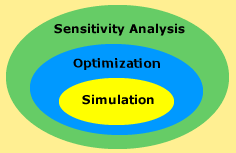 HOMER is the global standard in microgrid software, based on decades of listening to the needs of users around the world with experience in designing and deploying microgrids and distributed power systems that can include a combination of renewable power sources, storage, and fossil-based generation (either through a local generator or a power grid). The HOMER (Hybrid Optimization of Multiple Energy Resources) model greatly simplifies the task of designing hybrid renewable microgrids, whether remote or attached to a larger grid. HOMER's optimization and sensitivity analysis algorithms allow you to evaluate the economic and technical feasibility of a large number of technology options and to account for variations in technology costs, electric load, and energy resource availability. Originally designed at the National Renewable Energy Laboratory for the village power program, HOMER is now licensed to UL.
HOMER is the global standard in microgrid software, based on decades of listening to the needs of users around the world with experience in designing and deploying microgrids and distributed power systems that can include a combination of renewable power sources, storage, and fossil-based generation (either through a local generator or a power grid). The HOMER (Hybrid Optimization of Multiple Energy Resources) model greatly simplifies the task of designing hybrid renewable microgrids, whether remote or attached to a larger grid. HOMER's optimization and sensitivity analysis algorithms allow you to evaluate the economic and technical feasibility of a large number of technology options and to account for variations in technology costs, electric load, and energy resource availability. Originally designed at the National Renewable Energy Laboratory for the village power program, HOMER is now licensed to UL.
Simulation, Optimization, Sensitivity Analysis
HOMER microgrid software provides the detailed rigor of chronological simulation and optimization in a model that is relatively simple and easy to use. It is adaptable to a wide variety of projects. For a village or community-scale power system, HOMER can model both the technical and economic factors involved in the project. For larger systems, HOMER can provide an important overview that compares the cost and feasibility of different configurations, so that designers can use more specialized software to model technical performance.
HOMER is accessible to large set of users, including non-technical decision makers. Chronological simulation is essential for modeling variable resources, such as solar and wind power and for combined heat and power applications where the thermal load is variable. HOMER’s sensitivity analysis helps determine the potential impact of uncertain factors such as fuel prices or wind speed on a given system.
HOMER models both conventional and renewable energy technologies, either as a microgrid or as distributed generation within a larger grid:
- solar photovoltaic (PV)
- wind turbine
- run-of-river hydro power
- biomass power
- generator: diesel, gasoline, biogas, alternative and custom fuels, cofired
- electric utility grid
- microturbine
- fuel cell
- flywheels
- battery bank
- flow batteries
- hydrogen
- daily profiles with seasonal variation
- deferrable (water pumping, refrigeration)
- thermal (space heating, crop drying)
- efficiency measures
